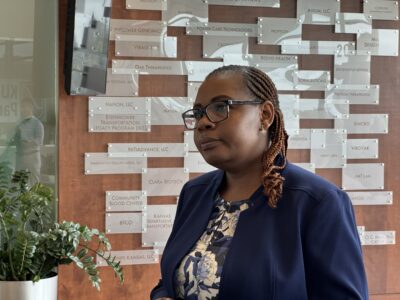KU School of Education reconfigures Teacher Preparation Program to save students money

From left, KU junior Lauren Eighme, of Overland Park, gets some help from KU graduate student Maggie Osei. Eighme is getting ready to enter the Teacher Preparation Program at KU, which is now a four-year program.
New students studying to become teachers won’t need to spend as much time in class at Kansas University or in school districts off campus — unless they want to pick up a master’s degree as well.
The School of Education’s reconfigured Teacher Preparation Program is being constricted to four years instead of five, allowing students to pick up their Bachelor of Science degrees — and, perhaps more important, their teaching certificates — while saving time and tuition.
“In this day and age — in this economy — I think we felt guilty at keeping students for five years,” said Sally Roberts, associate dean for undergraduate programs and teacher education. “They had to pay (graduate) tuition, racking up bigger and bigger student loan bills, to go out and take a job that had the earning power that is not that of a doctor or a lawyer.
“Teachers don’t make a lot of money when they get out. And there are not a lot of teaching jobs out there.”
With those factors in play, students entering the program will be picking up both value and flexibility, Roberts said. All of the strengths of the five-year program — including two separate stints teaching in elementary or secondary classrooms off campus — will remain intact, only with some on-campus courses “compressed” to make better use of students’ time.
Teachers still need to meet state standards for teaching, and that means taking enough history courses to be a history teacher, or enough math classes to be a math teacher, or enough English courses to teach English and on and on.
To help ensure that students still will have enough time to get those courses in, students enrolling in the Teacher Preparation Program now enter during the spring semester of their sophomore years instead of the first semester of their junior years.
The decision to switch to a four-year program, announced two years ago, led to an in-depth study that allowed the program to become even stronger, Roberts said.
“While you’re doing it,” she said, “you might as well make it better.”
Even with the ability to receive a bachelor’s degree — and, perhaps even more important, a state teaching certification — in four years instead of five, school officials still expect many students to stick around for a fifth year.
That’s because the fifth year could result in a master’s degree — a big switch from the previous model, after which a teacher typically would enter the market with a bachelor’s degree and 15 hours of credit toward a master’s.
The changes going into effect this year promise to open up valuable opportunities for prospective teachers, said Mike Neal, assistant dean for academic services.
“In these economic times, people need more flexibility,” Neal said. “And this does that for them.”
Also set for adjustments will be the students’ field assignments, considered critical for students as they prepare to enter the profession.
Students still will participate in two separate assignments, at two different times, in two different districts and grade levels. But instead of students finishing their field assignments and then returning to campus to finish up practical courses, such courses are expected to be included during those periods.
A student could be teaching in a high school during the day, for example, and then taking a KU course at night.
“It could be a behavior management class — how to manage their environment, how to manage students,” Roberts said. “They’ll learn about it in that class, and then go practice that in their student teaching.
“Everything is going to be designed in those classes to be practiced with that student-teaching experience. Everything will be embedded.”







